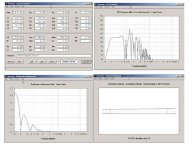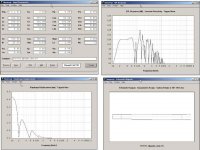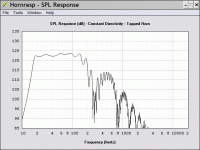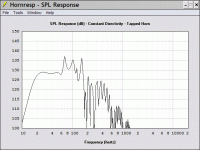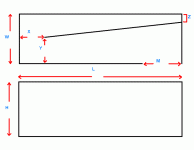Compression chamber
http://melhuish.org/audio/horndesign.html
gives the equation:
Vb= Vas
----------------
Fc
-------- -1
(Fs * Qts)
Vb= rear compression chamber
Fc= cutoff frequency of horn flare
Fs, Qts = driver being used parameters
My question is, in what units are Vas - liters or Meters squared? Most of the units for determining horn parameters are in Meters squared.
http://melhuish.org/audio/horndesign.html
gives the equation:
Vb= Vas
----------------
Fc
-------- -1
(Fs * Qts)
Vb= rear compression chamber
Fc= cutoff frequency of horn flare
Fs, Qts = driver being used parameters
My question is, in what units are Vas - liters or Meters squared? Most of the units for determining horn parameters are in Meters squared.
jnb said:Does this design look useable?
looks nice, since no big notches. the peaks are easily equalized, but you can do not much about notches. i would use it. but be sure to check what maximum spl you can get with it and if thats enough for you, at what point your highpass filter should be for excursion controll below cutoff and if the group delay is within reasonable numbers.
then the last problem will be to translate this design into an actual horn, since you will have to have a fold in there. but to my experience it should be quite close with one fold only. if your design can stand some errors, it will be even better. you can test this by changing each parameter slightly, simulate with maybe 5-10% more or less for each value and look if the response stays just about the same or if there will be huge changes - which would be bad.
15 inch tapped horn
I have a driver with the following parameters:
Driver size = 15 inch
TS PARAMETERS
Z=50.48
Fs=26.56
Pe=600
SPL=88.09
Re=3.6
Le=2.4599
BL=19.43
Xmax=14mm
Cms=0
Qms=6.55
Qes=0.5
Qts=0.47
Sd=1E-5
Vas=112.4
Could anyone offer assistance in designing a tapped horn using this driver ? I am looking for 20100 hz with corner loading. I built the 30 hz horn using a 12 inch driver I had laying around (models well) and love it...but the 12 inch driver is a bit....excursion inhibited...
I have a driver with the following parameters:
Driver size = 15 inch
TS PARAMETERS
Z=50.48
Fs=26.56
Pe=600
SPL=88.09
Re=3.6
Le=2.4599
BL=19.43
Xmax=14mm
Cms=0
Qms=6.55
Qes=0.5
Qts=0.47
Sd=1E-5
Vas=112.4
Could anyone offer assistance in designing a tapped horn using this driver ? I am looking for 20100 hz with corner loading. I built the 30 hz horn using a 12 inch driver I had laying around (models well) and love it...but the 12 inch driver is a bit....excursion inhibited...
If I use the normal folded type but put the mouth in the side so the driver is side on to me, will this work well and what will it likely do to the upper bass/mids?MaVo said:the last problem will be to translate this design into an actual horn,
zlast's 15inch tapped horn
Hi zlast: I tried to type your speaker values into hornresp, and came up with the design enclosed. It would be intersting to know what model speaker you had in mind, and how close the T/S parameters really are. Hope this is what you had in mind, and I hope you can read it as the file limit forced substantial picture reduction.
Hi zlast: I tried to type your speaker values into hornresp, and came up with the design enclosed. It would be intersting to know what model speaker you had in mind, and how close the T/S parameters really are. Hope this is what you had in mind, and I hope you can read it as the file limit forced substantial picture reduction.
Attachments
jnb said:Does this design look useable?
I assume so. This appears to be an example of using software to design something that traditional T/S horn math won't do AFAIK. For sure it looks a lot better than what I got using Prof. Leach's math for this BW, though it's to be expected since it's so much smaller than yours at ~421 L net. When I use the proper expansion though, it's much better, which again is to be expected with a ~1839 L net bulk.
Where it really 'shines' is in a corner loaded max BW app, though at ~3945 L net it's not a viable option for the vast majority of folks:
GM
BTW, are these measured specs as they are somewhat different than those published by Eminence?
Attachments
Re: 15 inch tapped horn
Here's a somewhat larger ~448.1 L net conic TH with 35 V input to reach Xmax @ ~16 Hz and using a reverse calc'd 831.5 cm^2 Sd since the published spec is clearly too large for a 15" driver:
GM
zlast said:
I am looking for 20100 hz with corner loading.
Here's a somewhat larger ~448.1 L net conic TH with 35 V input to reach Xmax @ ~16 Hz and using a reverse calc'd 831.5 cm^2 Sd since the published spec is clearly too large for a 15" driver:
GM
Attachments
I get just over 800L, unless I'm mistaken (metric?).GM said:at ~3945 L net it's not a viable option for the vast majority of folks:
They seem to have changed since I last checked.BTW, are these measured specs as they are somewhat different than those published by Eminence? [/B]
OK, here's what I'm planning. The standard rectangular box with a tapered divider that has a CSA of 3600 + 1000 cm^2 (about 26.7" per side, or a rectangle thereof) not counting timber thicknesses. Length of cabinet, half S2 plus S1 = 180cm or 71". Total 50,600" ^2 or 29' ^2.
I've noticed that I can make good size compromises which evenly reduce the level below 100Hz, leaving all else the same. I may have to notch just above 100Hz but it may be worth it.
I've also noticed simulating an exponential S2 seems to have no benefit in this configuration.
I've noticed that I can make good size compromises which evenly reduce the level below 100Hz, leaving all else the same. I may have to notch just above 100Hz but it may be worth it.
I've also noticed simulating an exponential S2 seems to have no benefit in this configuration.
GM said:
Where it really 'shines' is in a corner loaded max BW app, though at ~3945 L net it's not a viable option for the vast majority of folks:

I wonder how such a horn would sound / feel.
15 inch TH
Here's a somewhat larger ~448.1 L net conic TH with 35 V input to reach Xmax @ ~16 Hz and using a reverse calc'd 831.5 cm^2 Sd since the published spec is clearly too large for a 15" driver:
GM
Hi zlast: I tried to type your speaker values into hornresp, and came up with the design enclosed. It would be intersting to know what model speaker you had in mind, and how close the T/S parameters really are. Hope this is what you had in mind, and I hope you can read it as the file limit forced substantial picture reduction.
Thanks GM and tb46 ! I think I can make out everything in the Horn response output. Tb46...Am I correct that the TH you modeled would be 450mm internal width , throat 50 mm ? How do I determine the Length, Width, Height, mouth area (L,W,H,X,Y,Z,M in attached gif)?
Here's a somewhat larger ~448.1 L net conic TH with 35 V input to reach Xmax @ ~16 Hz and using a reverse calc'd 831.5 cm^2 Sd since the published spec is clearly too large for a 15" driver:
GM
Hi zlast: I tried to type your speaker values into hornresp, and came up with the design enclosed. It would be intersting to know what model speaker you had in mind, and how close the T/S parameters really are. Hope this is what you had in mind, and I hope you can read it as the file limit forced substantial picture reduction.
Thanks GM and tb46 ! I think I can make out everything in the Horn response output. Tb46...Am I correct that the TH you modeled would be 450mm internal width , throat 50 mm ? How do I determine the Length, Width, Height, mouth area (L,W,H,X,Y,Z,M in attached gif)?
Attachments
zlast 15 inch TH
Hi zlast: The fields S1 to S5 are in cm^2 and the lengths are in cm. Your are looking at a throat area of 450cm^2 and a mouth of 750cm^2. In your drawing: The speaker would go into the slanted divider board 50cm from the center of the speaker to the throat (Z). The length 350cm is from the front of the speaker to the back of the speaker, and the remaining length of 50 cm is from the back of the speaker to the mouth (M). This is just one design example and the possibilities are (almost) endless. I would recommend downloading David McBean's Hornresp, it's free, and working through the wiki on how to use it is very informative. Hope this helps.
Hi zlast: The fields S1 to S5 are in cm^2 and the lengths are in cm. Your are looking at a throat area of 450cm^2 and a mouth of 750cm^2. In your drawing: The speaker would go into the slanted divider board 50cm from the center of the speaker to the throat (Z). The length 350cm is from the front of the speaker to the back of the speaker, and the remaining length of 50 cm is from the back of the speaker to the mouth (M). This is just one design example and the possibilities are (almost) endless. I would recommend downloading David McBean's Hornresp, it's free, and working through the wiki on how to use it is very informative. Hope this helps.
I created a simple spreadsheet to calculate dimensions for TH's which have S12 = S34 (distance throat to cone = mouth to cone). It also helps you to play with the numbers in hornresp: When you for example alter the offset from throat to cone or mouth to cone it calculates the input parameters for hornresp for you on the basis of a constant flare from throat to mouth.
You can DL it here:
http://www.volvotreter.de/dl-section.htm
You can also enter thickness of wood to use. It's not 100% precise although it gives you a quick overview on the size of the horn and it's volume.
Erik
You can DL it here:
http://www.volvotreter.de/dl-section.htm
You can also enter thickness of wood to use. It's not 100% precise although it gives you a quick overview on the size of the horn and it's volume.
Erik
GM, in post 1050 was the volume of that really 3000+ liters?? Its hard to tell what is what. Was anything else incorrect about that sim?
MaVo said:
I wonder how such a horn would sound / feel.
Well, I can only speculate, but due to its low Xmax and limited 'sub' BW I'm thinking that while it would be impressive with reasonably low distortion and a certain tangible 'feel' to the bass like one gets in a church or similar venue with an organ, two ServoDrive Contrabass (CB) subs (~8 ft^3/cab) and plenty of power will outperform it in every way, so not a design to waste time/$$/effort on IMO.
Regardless, at this level of performance these powerful systems require an extremely well constructed room. I had a pair of CBs for awhile driven with 500 W and they tore my suspended floor, stick built house apart reproducing low organ notes, etc., causing the drywall ceiling to fall in the listening room and cracking one of the concrete block pillars supporting the floor along with most of the drywall joints in the rest of the house, so no more thunderous sub bass/movie special effects for me unless I someday convert my concrete slab garage to a dedicated listening/HT room.
GM
- Home
- Loudspeakers
- Subwoofers
- Collaborative Tapped horn project

